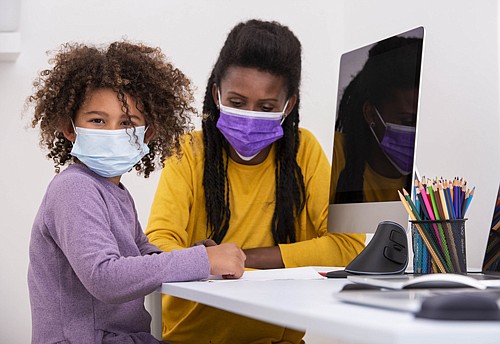As the COVID-19 pandemic continues, it is more important than ever that we help our children understand why wear- ing a face mask is important and how to do so correctly to protect themselves and others. Following are some important tips for helping children of any age un- derstand and accept mask-wearing and to feel secure and comfortable doing so.
-
Make sure children understand why it’s important for everyone to wear a mask. Ask “why is it important for us to wear our masks?” and let the child’s answer guide the need for addi- tional information. By age 5, children can understand simple explanations about why we wear face masks (keeping germs away or keeping germs we may have away from others). Use simple words that won’t frighten your child.
-
Check in with your child about their feelings around mask wearing. For older children this may include their feelings around COVID in general. Listen and let them know that that feelings about this are normal. And be sure to share your own feelings – “I agree, this really stinks right now.”
-
For younger children, incorporate mask wearing in play. Have a favorite stuffed animal wear a mask. Draw pic- tures with people wearing masks. If your child likes to pretend they are going to the store, wear your masks when you are playing store.
-
Communicate that wearing a mask is a rule right now. Just like it’s a rule that we look both ways before crossing the street, wearing a mask when we are outside of our house is a rule right now.
-
Offer your child choices where they exist — for example, if you are making your own masks, let your child pick out the fabric they would like for their mask; older children can help make their own masks; if purchasing masks, let children pick out the masks they like. There are so many fun options with sports team, super heroes, crayon colors, etc.
-
Practice wearing face masks before they might need to wear one outside of your home. Teach them how to put them on and take them off.
-
Try different kinds of masks and ask your child which one seems the most comfortable— especially if the child will need to wear this mask at child care or school for longer periods of time. Practice wearing the mask for longer periods of time to see which mask is the most comfortable. Identify any options for stepping away from a group environment to take a break from mask wearing— for example when it’s outside playtime at child care, speak with the child care provider about taking a break from mask wearing while continuing to monitor for social distancing as much as possible.
-
Adults and older siblings are great role models. When adults and siblings in the family wear face masks, children will feel more comfortable doing it too.
-
Tell your child in advance— The day before if possible, if they are going somewhere where they will need to wear a face mask.
-
Make sure you and your child are wearing your mask correctly— The mask should cover your nose and mouth and tuck under your chin. Masks come in different sizes, so make sure you have the correct size mask for your child.
As we all continue to be focused on staying healthy and safe, wearing a mask is an important part of limiting the spread of COVID-19. All children over the age of two benefit from following this current rule, and parents and other family members are key to helping them understand why it is important and feeling comfortable with it.
Shannon Joslin, MS, is a Certified Child Life Specialist, and Manager of the Child Life program at the University of Maryland Medical Center/University of Maryland Children’s Hospital.
